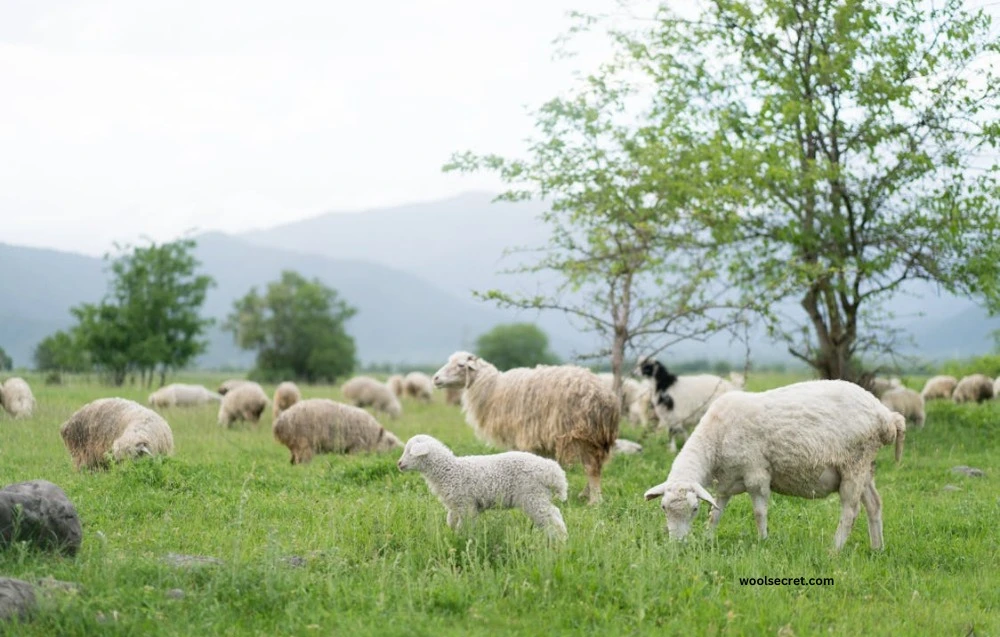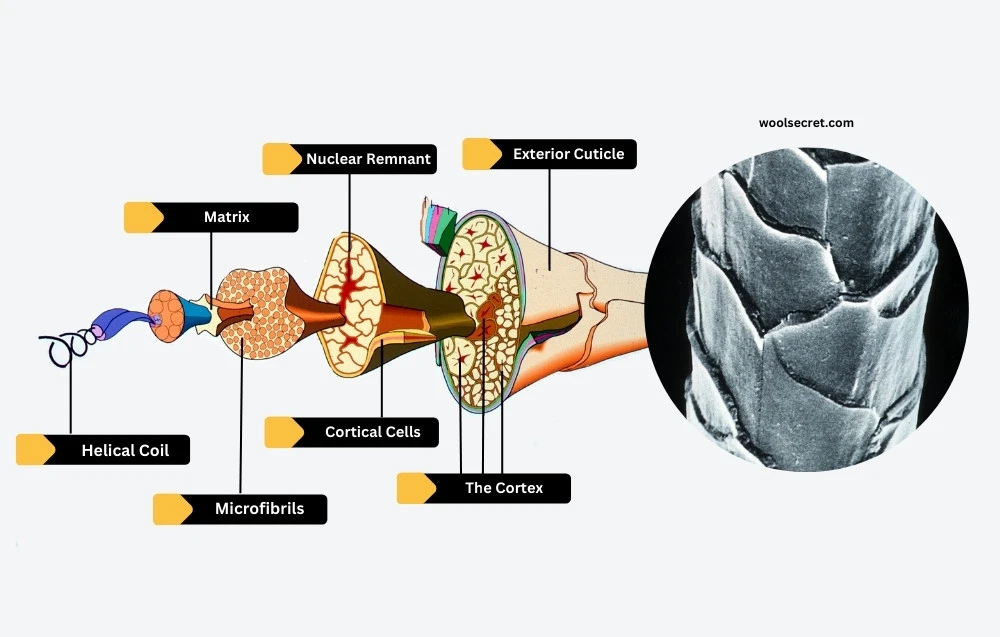The science behind Merino wool’s exceptional performance lies in its fine fibers, complex internal structure, and unique ability to interact with moisture. This makes it a versatile material that is as suited to luxury fashion as it is to high-performance sportswear, catering to a diverse audience with varying needs and concerns.
Whether you’re a fashion enthusiast, environmental advocate, textile professional, outdoor athlete, or savvy shopper, understanding all the science behind Merino Wool can offer Great Benefits in your field.
This insight enhances product selection, sustainability practices, and innovation, directly addressing your needs and interests, and showing How Merino wool is valuable despite its drawbacks.
Table of Contents
The Evolution and Origin of Merino Wool
Once upon a time, in the heart of Spain, Merino sheep began their journey. Their wool, known for its unparalleled quality, revolutionized the textile industry. Through centuries of careful breeding, these sheep developed a wool that was not just fine but durable and soft, making it a prized material in today’s fashion industry.

The story of Merino is not just about sheep; it’s a narrative deeply entwined with Spain’s history and its economic strategies. Once fiercely guarded, exports of these sheep were banned to safeguard Spain’s dominance in the wool market.
However, with time, the world saw restrictions relax, allowing Merino to grace pastures worldwide, embracing new climates and environments.
Australia embraced Merino in the 19th century, nurturing it to become the leading producer of this luxurious wool. Breeders meticulously worked to refine wool’s fineness and fleece weight, elevating Merino wool to the status of a must-have for anyone seeking luxury and comfort. Its adaptability proved to be a key factor in its enduring success.
Today, the legacy of Virgin Wool and Merino spans across continents, from New Zealand to South Africa and the United States. Behind the scenes, genetic research and sustainable practices play crucial roles, ensuring Merino’s future shines as bright as its past. Merino wool remains a cornerstone of the fashion world, celebrated for its softness, versatility, and sustainability.
The Science of Merino Wool and its Fibers
The science behind Merino wool’s unique properties lies in its distinct fiber structure, which sets it apart. This characteristic makes Merino wool more innovative in use compared to Different Varieties of Wool.
- Merino wool comes from sheep known for producing the world’s finest and softest wool, perfect for luxurious yet practical attire.
- These fibers are ultra-fine, offering unmatched softness and comfort against the skin, far surpassing coarser wools in quality.
- Merino’s unique properties are due to microscopic scales and cortical cells, enhancing its durability and flexibility, key for everyday wear.
- Lanolin and keratin, found naturally in the fibers, provide Merino wool with its water-repellent and antibacterial properties, keeping you dry and odor-free.
- The fibers’ ability to absorb moisture yet remain comfortable helps regulate body temperature, ensuring warmth in cold and coolness in hot environments.
- Merino wool’s breathability and moisture-wicking capabilities make it an ideal choice for clothing that keeps the wearer comfortable across diverse temperatures.
- The natural crimp in Merino fibers adds volume and insulation, enhancing its ability to trap heat and provide substantial warmth.
- Understanding Merino wool’s science provides valuable insights into designing garments that offer optimal comfort, functionality, and sustainability, a testament to nature and science’s sophisticated interplay.
These points highlight how the intricate structure and natural composition of Merino wool fibers result in a material that is both luxurious and practical, perfectly blending nature with science for sophisticated, sustainable, and functional fashion.
Anatomical Wonders of Merino Wool
Merino wool’s fiber is renowned for its unique properties, besides any Merino Wool Substitute thanks to its complex anatomy. The cuticle’s outer layer offers protection and water repellency with a waxy coating. This layer shields the wool from moisture and stains.

Inside, the cortex contains para-cortical and ortho-cortical cells, vital for the wool’s crimp and insulation capabilities. These cells give Merino wool its texture and warmth, keeping you cozy in cold temperatures.
Macrofibrils and microfibrils in the cortical cells contribute to the fiber’s strength and flexibility. The matrix, rich in high sulfur proteins, allows the wool to absorb moisture, enhancing comfort and making it fire and static-resistant.
This intricate structure not only contributes to Merino wool’s resilience and elasticity but also ensures it maintains comfort in various temperatures. The anatomy of Merino wool is key to its unique properties, making it a luxurious yet practical choice.
How Wool’s Structure and Composition Are Key to Its Scientific Properties
Merino wool is fascinating, combining strength, elasticity, and thermal insulation through its unique composition. Its fibers contain keratin, a protein that’s incredibly versatile. This complex arrangement of cells includes a protective cuticle layer and a cortex. The cortex has crimp-contributing cortical cells, which enhance wool’s elasticity.
The crimp in merino wool allows it to absorb moisture without feeling wet, maintaining its insulating properties. This characteristic is vital for temperature regulation, keeping you comfortable in diverse climates. Wool’s characteristics showcase its adaptability and resilience, reflecting a sophisticated natural design.
Through gas chromatography and protein chemistry, we understand wool’s properties better. Its structure supports moisture management and durability, making merino wool exceptional. Its scientific properties explain why wool garments are so cherished.
Additionally, A study that compares the fiber diameter and curvature of white and black Portuguese Merinos. Interestingly, both breeds exhibit similar measurements, averaging around 25 µm, with no significant differences between them.
However, the study reveals a twist – the black Merinos show greater variability in these traits, as evidenced by higher standard deviations in both diameter and curvature.
Merino’s Technological Triumphs
Merino wool has always been at the forefront of fashion and activewear, thanks to its innovations in textile technology. Its unique textures and finishes make it stand out.
Its fibers are naturally breathable, moisture-wicking, and odor-resistant, making it perfect for any climate or activity. Truly a luxurious, yet practical choice.
Scientific research on Merino wool focuses on its molecular structure, including proteins and lipids. This explains its fire resistance and dye-absorbing capabilities.

The sustainability of Merino wool is unmatched. It’s biodegradable, renewable, and eco-friendly, decomposing in soil to release nutrients back into the earth.
Technological advances in treating and processing Merino wool have led to high-performance garments that are both aesthetically pleasing and comfortable.
Through ongoing research, the boundaries of What Merino wool can do innovatively are constantly being pushed. It’s a textile revolution in our closets.
How Does Wool Fabric Impact the Environment
Merino wool is a natural textile that’s inherently non-impactful on the environment. Unlike synthetic fibers, it produces sustainable results without degrading the environment. Wool comes from sheep that can live happy, free lives.
However, not all wool production is environmentally friendly. Some practices are inherently inhumane and harmful, causing soil degradation and pollution. Sustainable practices are crucial for wool’s positive environmental impact.
Animal rights organizations, like PETA, often highlight the dire effects of wool production. Toxic chemicals used in processing can overflow, polluting waterways and damaging land and animal lives.
Sustainable wool production involves ethical treatment of animals and environmentally sound practices. It avoids overcrowding, inhumane treatment, and environmental damage, focusing on renewability and biodegradability.
Through innovation and technology, the wool industry can reduce its environmental impact. Advances in processing and treatment can make wool production more eco-friendly, supporting both healthy ecosystems and animal welfare.
How Does Merino Wool Work?
Merino wool’s secret starts with Merino sheep, prized for their softest, finest wool in the world. Unlike other wools, Merino fibers are incredibly fine, making the wool soft and comfortable against the skin.
These fibers have a microscopic structure of keratin, similar to human hair, and scales that help absorb moisture. This makes Merino wool excellent at regulating body temperature, keeping you warm in cold and Cool in Hot Environments.
Merino wool manages water uniquely, absorbing a significant amount of moisture without feeling wet. Its crimp creates air pockets, enhancing insulative properties and trapping warm air near the skin.
Moreover, Merino wool is durable and resilient, perfect for long-lasting wear. Its cortical cells and matrix are rich in high-sulfur proteins, adding to its elasticity, fire-resistant, and anti-static properties.
This blend of natural resources and sustainable farming practices makes Merino wool a renewable fiber with exceptional qualities. Its ability to adsorb moisture and generate heat through a chemical reaction adds an extra layer of warmth, demonstrating the complex science behind its remarkable functionality.
What is Special About Merino Wool
Merino wool stands out for its unique blend of warmth, lightness, and fire resistance, alongside moisture-wicking and odor-resistant properties, making it a versatile, All-Season Choice For Comfort and Safety.
It Can Stay Warm While Being Lightweight
Merino wool’s physical properties allow it to trap air, making it an Excellent Insulator in Cold. Even when lightweight, it keeps you warm without having to pull heat from your body. This magic happens because of the natural kinks and bends in the fibers.
Humans have recognized the insulating abilities of sheep’s wool for years, marveling at how it can keep us warm while being so light. The cellular and chemical structure of Merino wool contributes to this phenomenon, making each garment a piece of wearable magic.
This Wool is not just for clothes; it’s also used in homes and buildings as sustainable, recyclable insulation. Its ability to stay warm while being lightweight has made it well-regarded for various applications, beyond just fashion or activewear.
It Can Generate Heat
Yes, Merino wool is a marvel among fabrics, able to generate heat as it dries. This unique ability makes it a rare and cherished garment choice, especially when wet. The water, once adsorbed and trapped in the porous fibers, undergoes a transformation.
Inside these fibers, hydrogen bonds in the water break down, a process that creates a chemical reaction producing heat. Experiments have found that just 1kg of Merino wool can produce as much heat over 8 hours as an electric blanket, showcasing its incredible warmth and efficiency.
It Can handle Water Well
Merino wool’s natural water-resistance and ability to wick moisture away make it stand out in the fabric world. Unlike others, wool adsorbs water, making it different and special. This means that water molecules get trapped in wool’s naturally porous fibers, keeping you dry and comfortable.
When your wool garments get wet, they don’t feel especially wet against your skin. This is because Merino wool can handle water by adsorbing it and not allowing it to permeate. So, even when soaked, your clothes won’t cling uncomfortably to you.
Remember the incredible ability of wool to generate heat? Inside the fibers, as water condenses, it releases heat. This process not only keeps you warm but also helps water evaporate faster from the fabric. The outer layers of the fibers shed water and release moisture into the air as vapor, showcasing wool’s impressive mechanisms.
Thanks to wool’s cellular structure, biophysical qualities, and chemical properties, it excels in water adsorption and evaporation. This combination ensures that Merino wool garments will always keep you dry and comfortable, no matter the weather.
It is fire-resistant
Yes, Merino wool is renowned for its fire-resistance capabilities, a trait not found in many textiles. Its unique structure and chemical make-up mean wool fibers don’t catch fire readily. This safety feature is crucial for both clothing and home textiles, offering peace of mind.
Unlike synthetic fabrics, such as polyester, Merino wool doesn’t melt, drip, or stick to the skin when it burns. This natural fiber smolders for a short amount of time before self-extinguishing, making it safer during fire incidents. Its high ignition temperature, around 570-600° C, further underscores its fire-safe qualities.
Merino wool’s ability to produce less smoke and not emit toxic gas if it does catch fire sets it apart from other fabrics. This fire-resistance stems from the fact that it’s made of 100% natural proteins, showcasing wool’s inherent safety features.
Merino Wool is Super Comfy
Unlike traditional wool fabrics that can be itchy and coarse, Merino wool offers a different kind of comfort. Its fibers are finer, making them softer and less irritating to the skin. This quality significantly reduces the irritation and itchiness commonly associated with wool.
Merino wool’s fibers are about 20 microns in thickness, which is half the size of traditional wool. This smaller diameter makes Merino apparel not only flexible but also incredibly comfortable to wear. The longer fiber length means fewer ends poke out, minimizing the chance of annoyance.
The combination of fiber length, fiber diameter, and material quality improves overall comfort. Merino wool has been aptly nicknamed the “Cashmere of the People” for its accessible luxury and supreme softness, ensuring everyday comfort for its wearers.
Its Truly Odor Free
Merino wool is celebrated by travelers and outdoor adventurers for its remarkable ability to resist odor, making it an essential part of any adventure wardrobe. Unlike synthetic fabrics, Merino doesn’t trap odors even after multiple wears, keeping you fresh.
The secret behind Merino wool’s odor-resistant properties lies in its natural lanolin and microstructure. Lanolin fights off bacteria, and the scaly structure discourages bacteria growth, preventing that foul-smelling acid production.
Furthermore, Merino wool can readily absorb moisture, keeping the skin dry. This dryness is critical because bacteria thrive in warm, humid environments. By removing the moisture, Merino reduces the chance for odors to develop.
Additionally, the structure of Merino wool creates natural air pockets that trap odors. These odors are then released when the wool is washed, keeping the garment smelling fresh.
Overall, Merino wool garments maintain their freshness longer than clothes made from other materials. This makes Merino an excellent choice for those who prioritize cleanliness and comfort on their journeys.
Final Words
From its humble origins to becoming a staple in both fashion and performance wear, Merino wool stands out for its unparalleled warmth, comfort, and eco-friendly attributes. It’s truly a testament to how science can transform natural resources into everyday luxuries, making Merino wool essential for anyone seeking quality and sustainability in their wardrobe.
